Women fight for equality
Women fight for equality: some historical background
 In 1910, Clara Zetkin, member of the German Social Democratic Party and founder of the socialist women's movement, proposed the creation of "International Women's Day."
In 1910, Clara Zetkin, member of the German Social Democratic Party and founder of the socialist women's movement, proposed the creation of "International Women's Day."
This day is dedicated to the struggle for the right to vote and for gender equality. Her initiative is at the origin of the International Women's Day celebrated on 8 March every year since 1911.
This 8th of March is a reminder of the long series of struggles undertaken by women since the beginning of the twentieth century for the achievement of gender equality. Breakthroughs have been made possible thanks to long fights:
- 1903Marie Curie received her first Nobel Prize of physics. In 1911, she was awarded the chemistry Nobel Prize, making her the only woman to be granted two Nobel Prizes and the only one among all the winners to be rewarded in two separate areas of science
- 1903In England the suffrage movement, whose female activists were fighting for women’s right to vote, originated
- 1906In Finland, women's right to vote was granted for the first time in the world without any sexual, social or racial restriction. This same right was also granted for the first time in Turkey in 1930, in France in 1944, in Italy in 1945, in Cameroon in 1946, in Syria in 1949 and in Switzerland in 1971
- 1910Proposal for the establishment of the International Women's Day
- 1919The "tomboy" fashion was born in the United States and Europe under the leadership of Coco Chanel in particular, a trend that rose within the framework of the struggle for gender equality
- After the Second World WarMany countries, especially European ones, amended their matrimonial schemes. Women in these countries now enjoy the same rights as men in marriage. In Tunisia, the code of personal status was enacted on 13 August 1956. It was designed to achieve equality between men and women in many areas including the abolition of polygamy
- As of the 1960sWomen open a new front with the fight for the legalization of contraception
- As of the 1970sThe right to abortion in Europe, North America and parts of Asia was generalized, with Russia being the first country to allow it officially on 19 November 1920. African remains a very restrictive continent in this regard
The right to education of every individual is included in the Universal Declaration of Human Rights of December 10, 1948. However, many women are still deprived of it. The opportunity to pursue higher education is not equally offered to women and men in many countries.
Women fight for equality in the workplace
The fight for gender equality in the labor world has been part and parcel of that struggle led by women for many decades. Although gender differences are being gradually reduced, differences in status remain more or less significant and vary from one region to another.
According to studies conducted by the International Labour Office (ILO), women now account for more than 40% of the jobs offered in the world. Their arrival on the labor market has been a growth and evolution factor for competitiveness worldwide. Women head today over 30% of all the companies including proprietorships. They are more numerous in small and micro enterprises. They, account, therefore, for 24% of employers in the world outside MENA region where the percentage is only 6%.
Read also:
It is only in the recent past that women have applied for management positions. In insurance companies, women who occupy high responsibility jobs are still relatively rare.
In 2010, the "World Economic Forum" published a study showing that less than 5% of women are Chief Executive Officers (CEO) in large companies, members of the Organisation for Economic Cooperation and Development (OECD). Other reports mention that women are CEO in 5.6% of listed Chinese companies, 4% in South Africa and India, and 3% in Mexico. It should be noted that none of the companies listed on the French CAC 40 or the German DAX 30 was headed by a woman in 2012. The accession to leadership positions experienced significant growth in the more developed countries as from the end of 1970s.
As early as the 1950s, women’s say in finance started to pick up momentum, especially in the banking sector where this phenomenon is mostly noted. It is unlikely so for the insurance business. Companies in large cities are more concerned with the slow change in gender-driven structure than those in small provincial towns which tend to just follow the trend.
In developing countries, women’s access to even the least skilled positions is much slower. In the early 90s, women made up only 7% of the workforce of IT departments of Indian insurance companies.
Social changes slowly crack invisible yet very real walls. In general, the rising cost of living has gradually forced women to take on a role that was previously exclusively reserved for men, such as catering for the family’s material needs. In the US, four out of ten families are now supported exclusively by women.
Women fight for equality in insurance, a predominantly female sector in Europe
European round up
France is one of the European countries where the insurance industry has the highest enrollment of female employees. According to the 2014 report of the observatory of the insurance careers, women now account for 59.7% of the workforce and 45.2% of managers (+8.8 points in 10 years) including an increasing share of 27% at the level of management executives.
Evolution of the executive women’s share per class in France: 2003 - 2013
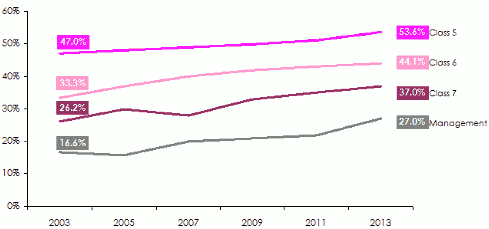 Source: 2014 ROMA ROFA report - report on the occupations of the insurance sector’s personnel (data as at 31/12/2013)
Source: 2014 ROMA ROFA report - report on the occupations of the insurance sector’s personnel (data as at 31/12/2013) Women’s share per occupation in 2013 in France
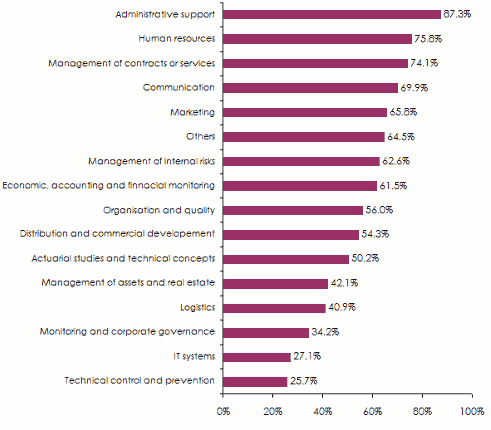 Source: 014 ROMA ROFA report - report on the occupations of the insurance sector’s personnel (data as at 31/12/2013)
Source: 014 ROMA ROFA report - report on the occupations of the insurance sector’s personnel (data as at 31/12/2013) In Germany, the European economic leader, women account for 49.7% of the total workforce. Only one insurer, the company Provinzial Rheinland Holding, appointed a woman, Beate Läsch-Weber, as a chairwoman.
In Spain, women represent more than half the workforce, 50.2% in 2013, compared to 37.1% in 1999. However , they are only 6.2% in managerial or executive committees.
In Italy, in 2013, the insurance industry employs 46.1% of women, 22.6% of whom are executives and 13.2% as managers.
In the United Kingdom, the insurance market counts about 50% of women, 20% of whom in executive committees.
Women fight for equality in the workplace: management positions
A 2014 report by the consultancy firm Catalyst has analyzed the position of women in the boards of directors in 45 countries. This study, which is spread over several years, has shown that in only four countries, the percentage of women was higher than 20% in boards of directors.
Percentage of positions in the board of directors held by women (survey conducted in 2013)
| >20% | 10-20% | 5-10% | <5% |
|---|---|---|---|
| Finland | Australia | Belgium | Bahrain |
| Norway | Austria | Brazil | Chile |
| Sweden | Canada | China | India |
| United Kingdom | Denmark | Greece | Japan |
| France | Hong Kong | Kuwait | |
| Germany | Indonesia | Oman | |
| Netherlands | Ireland | Portugal | |
| Poland | Italy | Qatar | |
| South Africa | Malaysia | South Korea | |
| Turkey | Mexico | Russia | |
| Switzerland | New Zeland | Taiwan | |
| United States | Singapore | United Arab Emirates | |
| Spain | |||
| Thailand |
Chairwomen at boards of directors are even rarer. Only in Norway and Turkey are percentages more significant with respectively 13.3% and 11.1%. Elsewhere the figures are close to zero.
However, many studies have established a link between women's participation in decision making and the positive results in companies.
Percentage of women as senior executives and top managers (ILO, 2012)
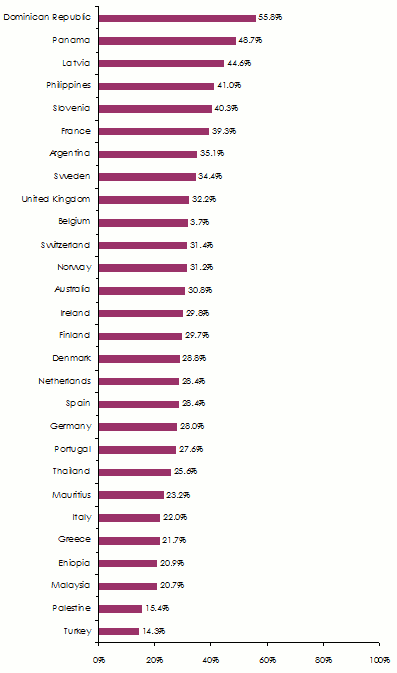 Source: ILO ’s database , June 2014
Source: ILO ’s database , June 2014 The obstacles to women’s access to decisional positions
Reconciling family and professional life is one of the main obstacles to gender parity, especially in areas where religious anchorage or the traditional perception of the family has been prevailing.
The training provided for women is sometimes an impediment to access positions of responsibility. Being more comfortable in areas of expertise, women are generally directed toward hyper specialization, which makes them less credible in the eyes of recruiters when applying for managerial jobs.
Their experience in this field is, therefore, not sufficiently diversified. They are not quite familiar with all the corporate activities. The study conducted by the International Labour Office in developing countries companies highlighted these trends.
While women have access to a large number of management positions, they tend to be guided towards certain executive functions. In insurance companies in particular, women are often confined to certain occupations such as communication, human resources, and legal positions.
Yet, a new trend has started to emerge now with more women heading toward technical professions such as actuarial specialty and risk management.
Percentage of companies employing women and men in different types of management
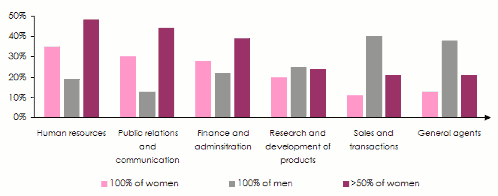 Source: Survey conducted in 2013 by the ILO with companies from 39 developing countries
Source: Survey conducted in 2013 by the ILO with companies from 39 developing countries In some countries, the economic difficulties have overshadowed gender equality, thus disregarding it as a priority. This is the case for example of Spain, where the 2007 law on gender equality called for the presence of 40% women in corporate boards of more than 250 employees. Unfortunately in reality this rate does not exceed 10% today.
In 2013, the Bureau for Workers’s Activities of the International Labour Organization listed 15 major barriers to the employment of women in higher positions, establishing that:
- women fulfill more family responsibilities than men;
- the roles given by society to men and women are different;
- companies have a male-dominated culture;
- the experience of women in corporate management is inadequate;
- purely female occupations are scarce;
- men are not encouraged to give up their professional responsibilities to take care of their families;
- policies and programs that promote gender parity remain insufficient within companies;
- clichés and stereotypes are prevailing in enterprises;
- women lack preparation for leadership;
- women lack flexibility to move towards other positions than those for which they have been trained;
- companies do not have a specific strategy for retaining skilled women;
- management is usually designed for men;
- career promotions are more generally available to men;
- Gender parity is not applied even when it is included in legislations;
- anti discrimination laws are not appropriate.
Women fight for equality: legislation and initiatives
In several countries, efforts are being exerted to encourage diversity in management teams. An evolution often supported by legislation that is fostering gender equity.
Female professional networks
In the United Kingdom, where since 1 January 2014 Inga Beale has been the first woman to have managed Lloyd's of London, women's networks have been set up. Some insurers such as Royal & Sun Alliance is planning to develop, as of this year, networking initiatives designed to bring together female insurance leaders with their counterparts from other businesses.
 |
In France, an agreement for the encouragement of gender diversity was signed in 2008. It provides particularly for the monitoring of actions designed to promote gender diversity and reconciliation between professional and private life. Since then, women's access to management positions has increased.
Female professional networks have also emerged such as Actu'Elles, for members of the institute of actuaries, or Ell'ianz for Allianz’ female general agents. These networks are not only places of exchange and information, but they are also designed to provide more visibility to their affiliates.
In Italy, some initiatives have made it possible to better meet the needs of female staff through flexible working hours, access to part-time, or the creation of corporate nursery schools.
The situation of women in insurance, in Africa and the Middle East
In Africa and the Middle East the way towards the achievement of gender parity in the insurance industry is still long. This activity remains largely in the hands of men.
Indeed, management, top executive office and committees and boards of directors are predominantly male. Initiatives to facilitate the advancement of women in the hierarchy are few and legislative developments in this direction are almost nonexistent.
This environment, hardly enabling for women, has not prevented a number of them to break into the insurance business and to reconcile work and family life perfectly, though.
The greatest success stories are those of Catherine Samba-Panza and Zoulikha Nasri.
Catherine Samba-Panza, Transitional Head of State Central African Republic | |
|---|---|
Before embarking on politics, Catherine Samba-Panza, joined in 1990 the Central African branch of the Allianz group where she spent 20 years before founding and running her own brokerage firm. | |
Zoulikha Nasri, Advisor to King Mohammed VI of Morocco | |
|---|---|
It was under her mandate that the Moroccan insurance market began its renovation. Five insurance companies have had their licenses withdrawn while merger and acquisition transactions were encouraged. Zoulikha Nasri is currently advisor to King Mohammed VI. | |
At the level of companies and large-scale insurance groups, women are increasingly present in management. In Africa the prize goes to NSIA Group (Côte d’Ivoire) in which 23% of the subsidiaries’ GM are women, according to Ramatoulaye Ndiaye, GM of NSIA Vie Senegal. Women are also present in large numbers as senior executives.
In Lebanon, the proactive policy of Zaris reinsurance broker propels women to the outposts. Over 60% of the company's employees are women and 50% of them hold managerial positions.
Portrait of ladies
According to a survey conducted by Credit Suisse and published in 2014, among 3 000 enterprises from 40 countries, companies that are most successful are those that have women in their boards of directors.
According to the OECD, the reduction of the gap between the employment rate of men and that of women is likely to allow global GDP to jump 12% in 15 years. These are good reasons to encourage insurers to further feminize their governing bodies.
Atlas Magazine below offers a portrait of 16 leading female insurers in Africa and the Middle East.
The portraits are presented in alphabetical order of country. The ranking also takes into account as a presentation criterion the nationality of the company’s head office and not that of the female leader.
- Benin: Geneviève Gbokede, Manager of SAECO Assurances
- Cameroon: Anette Ekollo Monthe, Deputy general manager of Activa Vie
- Cameroon: Prisca Soares, Secretary general of the African Insurance Organisation (AIO)
- Cameroon: Esther Tiako, General manager of NSIA and NSIA Vie Assurances
- Côte d'Ivoire: Janine Diagou, Board member and deputy general manager of NSIA Participations, general manager of the bank’s pole of NSIA group
- Côte d'Ivoire: Rosalie Logon, General manager of Atlantique Assurance
- Dubai, United Arab Emirates: Nawal Al-Qamaish, Manager of AIG Property & Casualty Middle East
- Gabon: Eugénie Victoire Ndende, Board member and general manager of ASSINCO
- Lebanon: Faten Douglas, Deputy general manager of Arope Insurance
- Lebanon: Kerstin Chalhoub, General manager of Zaris
- Mali: Aminata Cissé, General manager of Assurances Lafia
- Senegal: Ramatoulaye Ndiaye, Board member and general manager of NSIA Assurances Vie
- Senegal: Oumou Niang Touré, Board member, general manager of Askia Assurances
- Togo: Nelly Mongosso’o, General manager of Allianz Assurances
- Tunisia: Lamia Ben Mahmoud, Chaiman and general manager of Tunis Re
- Tunisia: Afifa Boughzou, General manager of CARTE Vie
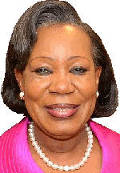 Catherine Samba-Panza has been president of the transitional Central African Republic since January 2014. She holds a specialized graduate degree (DESS) in insurance law obtained at the Université Panthéon-Assas (Paris II).
Catherine Samba-Panza has been president of the transitional Central African Republic since January 2014. She holds a specialized graduate degree (DESS) in insurance law obtained at the Université Panthéon-Assas (Paris II).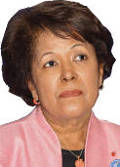 Zoulikha Nasri holds a PhD in insurance law from the University of Lyon (France). She worked for several years as manager of the insurance department at the ministry of finance in Rabat.
Zoulikha Nasri holds a PhD in insurance law from the University of Lyon (France). She worked for several years as manager of the insurance department at the ministry of finance in Rabat.